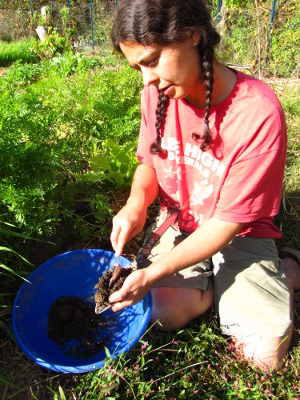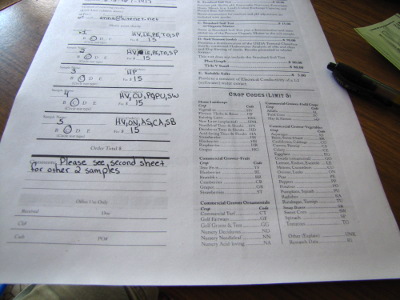
Holistic soil test analysis
 The
report from a typical soil test will tell you to
add a certain amount of nitrogen, phosphorus, and potassium to your
soil in order to achieve a certain yield, and might also tell you to
add
lime or sulfur to change your pH. This type of soil analysis
assumes that soil is like a checking account --- you put nutrients in
and your plants take the same amount out. Large-scale farmers
will add chemical fertilizers or --- if the fields are certified
organic --- mineral supplements and compost to supply the required
amount of each primary nutrient.
The
report from a typical soil test will tell you to
add a certain amount of nitrogen, phosphorus, and potassium to your
soil in order to achieve a certain yield, and might also tell you to
add
lime or sulfur to change your pH. This type of soil analysis
assumes that soil is like a checking account --- you put nutrients in
and your plants take the same amount out. Large-scale farmers
will add chemical fertilizers or --- if the fields are certified
organic --- mineral supplements and compost to supply the required
amount of each primary nutrient.
Holistic gardeners
understand that soil is
more complex, and
that the
physical environment and microorganisms work together to make nutrients
more or less available. You can compare this view of soil to a
mutual fund, with the combination of individual stocks and bonds
determining how much money is available at any given time. If
you're a real holistic gardener, you'll take the analogy one step
further and try to create soil where you're living on the interest, not
the capital.
Which is all a long way
of saying --- this lunchtime series isn't going
to show you the traditional way of interpreting your soil test
results. I'm assuming that you'll be adding half an inch to an
inch of high quality compost to your garden before each planting as a
matter
of course, so I won't mention nitrogen at all. Instead, I'll walk
you through the less well known but even more important fields on your
soil test report so that you can create a  well-rounded
soil that will
require fewer inputs every year.
well-rounded
soil that will
require fewer inputs every year.
If you don't have a soil
test for your own garden handy, this week's lunchtime series will be a
lot less fun. Check out this post
about where to send your soil tests
and be aware that fall is a great time to sample since testing labs are
less busy. I got my results via email less than a week after
putting our soil samples in the mail.
| This post is part of our Holistic Soil Test Analysis lunchtime series.
Read all of the entries: |
Want more in-depth information? Browse through our books.
Or explore more posts by date or by subject.
About us: Anna Hess and Mark Hamilton spent over a decade living self-sufficiently in the mountains of Virginia before moving north to start over from scratch in the foothills of Ohio. They've experimented with permaculture, no-till gardening, trailersteading, home-based microbusinesses and much more, writing about their adventures in both blogs and books.
Want to be notified when new comments are posted on this page? Click on the RSS button after you add a comment to subscribe to the comment feed, or simply check the box beside "email replies to me" while writing your comment.
